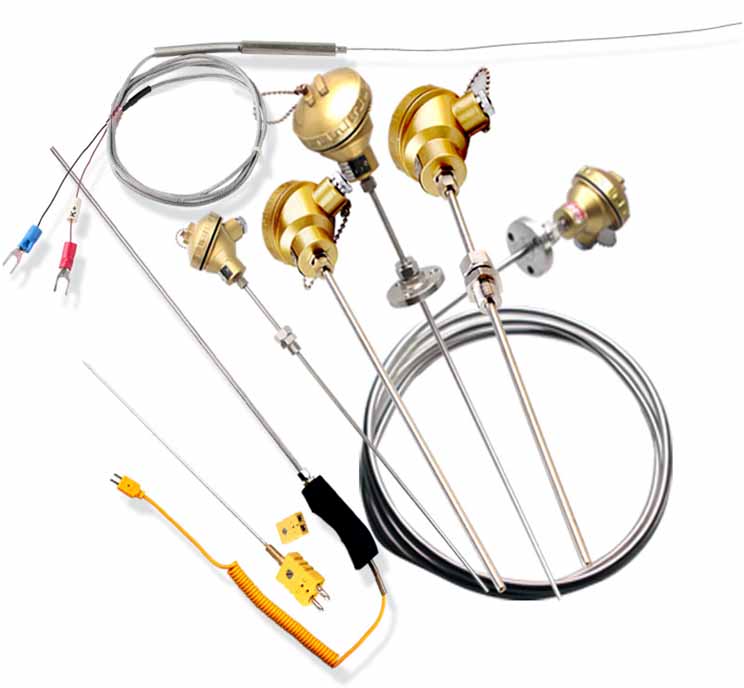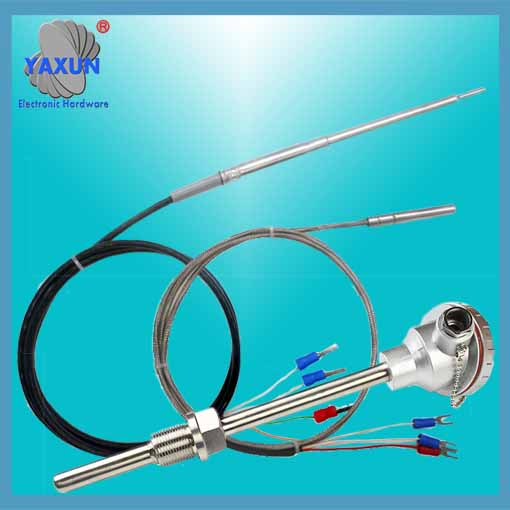Product Categories
Product Tags
Recent Posts
probe & cable of thermal resistance sensor
The probe & cableof platinum resistance sensor: stainless steel probe package, thread, magnetic body package, spring top tight, ABS shell, glass fiber and other waterproof protection temperature probes and High temperature wire silicone braided cable, mica wire, glass fiber wire, electronic wire, Teflon wire.
The probe & cableof platinum resistance sensor: stainless steel probe package, thread, magnetic body package, spring top tight, ABS shell, glass fiber and other waterproof protection temperature probes and High temperature wire silicone braided cable, mica wire, glass fiber wire, electronic wire, Teflon wire.
The principle of platinum resistance temperature measurement is the principle that the resistance value of the platinum resistance increases as the temperature increases.
Thermal resistance (PT100) is designed and manufactured using the basic principle that the resistance value of platinum wire changes with temperature. According to the resistance value R (℃) at 0℃, it is divided into 10 ohms (graduation number Pt10) and 100 ohms (graduation number Pt100), etc. The temperature measurement range is large, suitable for -200~850℃. The temperature sensing element of the 10 ohm platinum thermal resistance is made of thicker platinum wire, and its temperature resistance is obviously better than that of the 100 ohm platinum thermal resistance. Mainly used in the temperature zone above 650℃: 100 ohm platinum thermal resistance (PT100) is mainly used in the temperature zone below 650℃. Although it can also be used in the temperature zone above 650℃, the A-level error is not allowed in the temperature zone above 650℃.
What is a platinum thermal resistance?
The resolution of a 100 ohm platinum thermal resistance is 10 times greater than that of a 10 ohm platinum thermal resistance. The requirements for the secondary instrument are correspondingly more than an order of magnitude, so 100 ohm platinum thermal resistance (PT100) should be used as much as possible to measure the temperature in the temperature zone below 650 ℃.
The material of the frame of the temperature sensing element (PT100) is also the main factor that determines the temperature zone of the platinum thermal resistance. Common temperature sensing components include ceramic components, glass components, and mica components. They are made of platinum wire wound on the ceramic framework, glass framework and mica framework respectively, and then processed by complicated processes. Due to the different properties of the framework material itself, ceramic components are suitable for temperature zones below 850°C, and glass components are suitable for temperature zones below 550°C. There are a large number of thick film and thin film platinum thermal resistance temperature sensing elements on the market. The thick film platinum thermal resistance element is printed with platinum paste on the glass or ceramic base plate, and the thin film platinum thermal resistance element is sputtered with platinum paste on the glass or ceramic base plate, and then processed by photolithography. This kind of temperature sensing element is only suitable for the temperature range of -70~500℃, but this kind of temperature sensing element uses less materials, can be mechanized and mass-produced, has high efficiency and low price.
In terms of structure, platinum thermal resistance can also be divided into industrial platinum thermal resistance and armored platinum thermal resistance. Industrial platinum thermal resistance is also called assembling platinum thermal resistance, that is, the platinum thermal resistance temperature sensing element is welded on the lead wire and assembled in a metal tube or ceramic tube with one end closed, and then a junction box is installed; The armored platinum thermal resistance is a whole assembled by the platinum thermal resistance element, the transition lead, and the insulating powder in the stainless steel tube and then the die is pulled. It has the advantages of being solid, anti-vibration, winding, small wire diameter, easy to use and install, etc.

Armoured platinum thermal resistance sensor

Industrial platinum thermal resistance sensor
Contact Us
Waiting for your email, we will reply you within 12 hours with valuable information you needed.
 English
English العربية
العربية Български
Български 粤语
粤语 中文(简体)
中文(简体) 中文(漢字)
中文(漢字) Nederlands
Nederlands Suomi
Suomi Français
Français Deutsch
Deutsch Ελληνικά
Ελληνικά Magyar
Magyar Italiano
Italiano 日本語
日本語 한국어
한국어 Polski
Polski Português
Português Română
Română Русский
Русский Slovenščina
Slovenščina Español
Español Svenska
Svenska ภาษาไทย
ภาษาไทย Türkçe
Türkçe Tiếng Việt
Tiếng Việt

